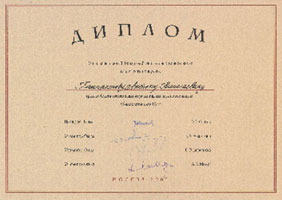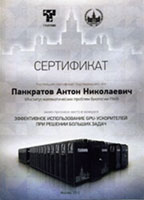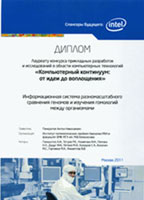Laboratory of data processing
Headed by Sergei A. Makhortykh, Cand.Sc. (Physics and Mathematics)
The laboratory deals with topical problems of computer science concerned with development of new technologies
for data array processing. The approaches used are based on combination of numerical and analytical methods
possessing the advantages of both. We have developed original methods for adaptive analytical approximation of
signals using modified classical orthogonal polynomials of continuous and discrete arguments and other
orthonormalized functions.
Analytical description of signals by truncated orthogonal series has a fixed structure which enables one to
derive analytical dependencies for obtaining various estimates and characteristics before the signal processing
has started.
The technology suggested is characterized by the following points:
- initial digital data arrays are analytically described by truncated orthogonal series with the use of
modified classical orthogonal bases;
- the process of adaptive analytical description of data arrays occurs automatically providing a desired
accuracy in the root-mean-square or uniform sense;
- realization of adaptive procedures (the choice of a proper base, its adaptation to a particular signal,
variation of the expansion depth) makes possible analytical description of signals by the most simple
expression, resulting in effective data compression;
- the process of signal expansion in terms of orthogonal series requires considerably fewer calculation
operations per unit information than traditional methods, such as least square method, spline-functions,
etc.
- expansion of signals in terms of orthogonal series is rigid (earlier calculated expansion coefficients
remain unchanged when additional coefficients are calculated), in other words, expansion coefficients are
linearly independent functionals. Besides, a sharp decrease in the dimensions of signal representation
enables one to solve effectively the problem of parametric identification in the space of expansion
coefficients without any additional regularization;
- obtaining of desired estimates and characteristics by way of rigid analytical transformations and
automatical input of final formulas spares researchers repeated calculations, rules out unaccounted
round-off errors, and increases the accuracy and speed of the calculations;
The formulas for getting various estimates and characteristics are summarized in special tables under the following
categories:
- the main operations of mathematical analysis;
- statistical evaluation (correlation analysis) and regression analysis;
- solution of integral-differential equations;
- parameter identification and diagnostics of objects under study, etc.
The technology developed is also suitable for planar and 3D images. The estimates and characteristics calculated
from one-dimensional curves are projections of the corresponding vector quantities.
Currently we are using the technology developed to solve the following problems:
- Analytical description of experimental data obtained as a result of full-scale and numerical experiments;
- Filtering of the experimental data in order to smooth out the high-frequency components and to exclude trend;
- Pattern recognition and image analysis with the help of expansion coefficients in relevant sets of functions;
- Optimal filtering of noisy experimental data by numerical solution of the Viener-Hopf equation;
- Solution of integral Fredholm equation of the first kind (by a modified method with "mixed" bases);
- Computer processing of tomograms and maps;
- Calculation and analysis of the models of physical fields in various geophysical systems;
- Diagnostics and control of mechanical systems by acoustical methods;
- Analysis and identification of stochastic data arrays (correlation and fractal analysis);
- Magnetic Encephalography.



Significant publications:
- A.F. Dedus, F.F. Dedus, M.N. Ustinin. "A new data processing technology for pattern
recognition and image analysis". Pattern Recognition and Image Analysis, vol. 2,
N 2, 1992, p. 195-207.
- A.F. Dedus, F.F. Dedus, S.A. Makhortykh and M.N. Ustinin. "Analytical description
of multidimensional signals for solving problems of pattern recognition and image
analysis". Pattern Recognition and Image Analysis, Vol. 3, pp. 459-469, 1993.
- M.N. Ustinin. "The real-time data processing in the flow cytometry experiments".
In RTD'94 Conference Proceedings, Dubna, 1994.
- A.F. Dedus, F.F. Dedus, S.A. Makhortykh, M.N. Ustinin. "Generalized
spectral-analytic method: Theoretical fundaments". Proc. SPIE, vol. 2363, 1995, p. 109.
- A.F. Dedus, S.A. Makhortykh, M.N. Ustinin. "Generalized spectral-analytic
method: Applications". Proc. SPIE, vol. 2363, 1995, p. 113.
- A.F. Dedus, S.A. Makhortykh, M.N. Ustinin. "Generalized spectral-analytic
method for the problems of signal processing and image analysis". Proc.
The 9th Scandinavian Conf. on Image Analysis, June 1995, Uppsala, Sweden, 1995, pp. 973-980.
|



